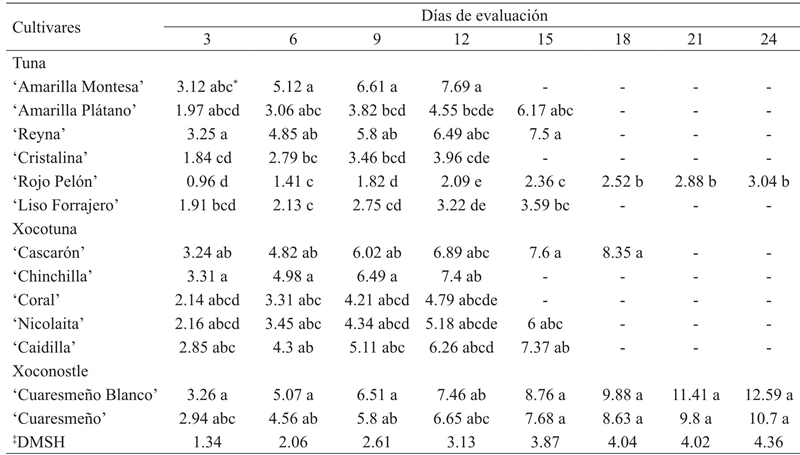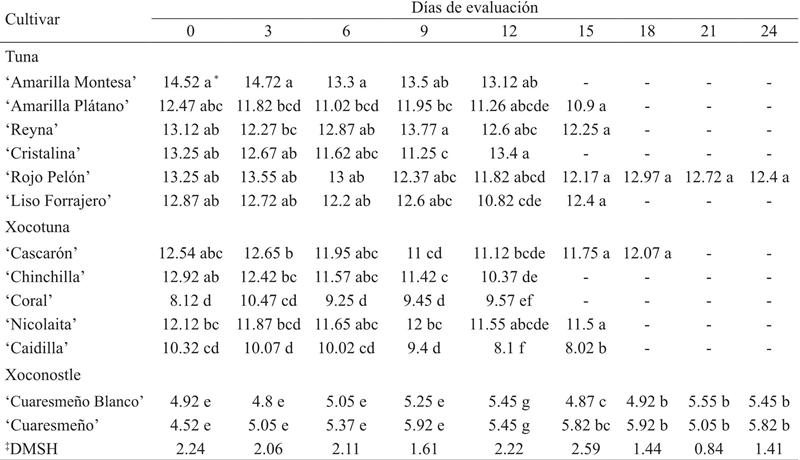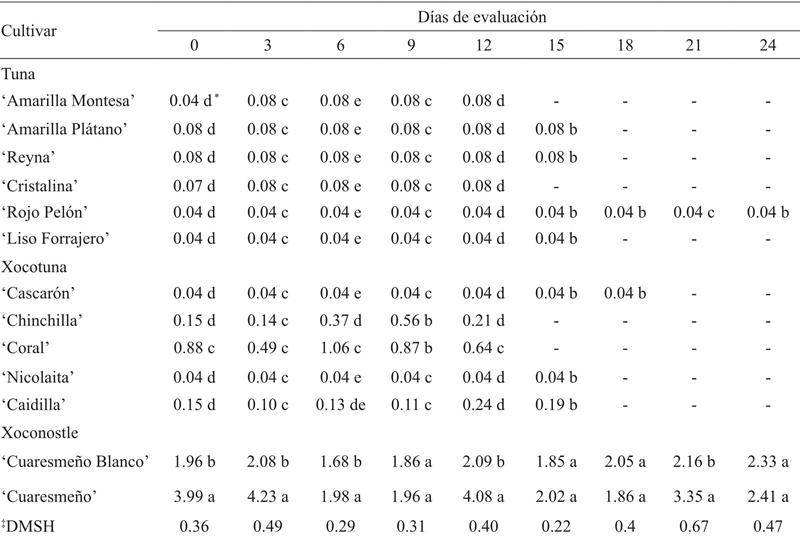Services on Demand
Journal
Article
Indicators
-
 Cited by SciELO
Cited by SciELO -
 Access statistics
Access statistics
Related links
-
 Similars in
SciELO
Similars in
SciELO
Share
Revista mexicana de ciencias agrícolas
Print version ISSN 2007-0934
Rev. Mex. Cienc. Agríc vol.8 n.1 Texcoco Jan./Feb. 2017
https://doi.org/10.29312/remexca.v8i1.82
Investigation note
Evaluation of some physical and chemical characteristics of fruits of xocotuna, tuna and xoconostle in postharvest
1Departamento de Fitotecnia-Universidad Autónoma Chapingo. Carretera México-Texcoco, km 38.5. Chapingo, Estado de México. México. CP. 56230.
2Centro Regional Universitario Centro Norte-Universidad Autónoma Chapingo. Cruz del Sur, núm. 100. Constelaciones, Zacatecas, Zacatecas. CP. 98060.
The objective of the present investigation was to determine some physical and chemical characteristics of xocotuna in comparison with tuna and xoconostle. The fresh fruits of xocotuna, tuna and xoconostle were used in physiological maturity. The percentage of weight loss, color (hue angle), shell thickness, total soluble solids and titratable acidity were evaluated. It was found that weight loss was similar between tunas and xocotunas, and greater than 8% in the xoconostles. The pitch angle had a tendency to decrease and increase during the evaluated period due to the increase of color of the pulp of the fruit. The thickness of the peel was different between cultivars and decreased as the evaluation time passed as a consequence of the ripening process. It was observed that the xoconostles presented lower content of total soluble solids unlike the tunas and xocotunas. Similar values of titratable acidity were observed between the cultivars of tuna and xocotuna, and in xoconostles, higher values.
Keywords: Opuntia spp.; natural hybrid; shell thickness; weight loss
El objetivo de la presente investigación fue determinar algunas características físicas y químicas de xocotuna en comparación con tuna y xoconostle. Se utilizaron frutos de xocotuna, tuna y xoconostle frescos en madurez fisiológica. Se evaluó el porcentaje de pérdida de peso, color (ángulo hue), grosor de cáscara, sólidos solubles totales y acidez titulable. Se encontró que la pérdida de peso fue similar entre tunas y xocotunas, y mayor a 8% en los xoconostles. El ángulo de tono tuvo una tendencia a disminuir y aumentar durante el periodo evaluado debido al incremento de color de la pulpa del fruto. El grosor de la cáscara fue diferente entre cultivares y disminuyó conforme paso el tiempo de evaluación como consecuencia del proceso de maduración. Se observó que los xoconostles presentaron menor contenido de sólidos solubles totales a diferencia de las tunas y xocotunas. Se observaron valores similares de acidez titulable entre los cultivares de tuna y xocotuna, y en xoconostles valores más altos.
Palabras clave: Opuntia spp.; grosor de cáscara; híbrido natural; pérdida de peso
Introduction
One of the great advantages that our country has is the genetic richness of the genus Opuntia which, due to its diversity of species and cultivars, is a plant resource of great importance, which has the particular characteristic that it can develop in arid lands where few plants can survive. From the economic and social point of view, its many nutritional, therapeutic, chemical, industrial, ecological and symbolic characteristics, among others, make it an important natural resource for the inhabitants of arid zones (Méndez-Gallegos and García-Herrera, 2006). Opuntia is a complex genus that includes species used for the consumption of soft cladodes, known in Mexico as “nopalitos”, obtained mainly from O. ficus-indica, or by its fruits (many wild and domesticated species), called tunas and xoconostles (Majure et al., 2012).
The xocotunas are probably natural hybrids of tuna and xoconostle, and belong to the following species: O. chavena Griffiths, O. lasiacantha Pfeiff, O. megacantha Salm-Dick, O. streptacantha Lem. and O. robusta Wendl. In general, its fruits are small, with fleshy mesocarp, spongy and a package of seeds in the central nucleus. In such a way that its type of fruit is similar to the one of the xoconostles but with semi-acidic or slightly sweet pulp. They differ from the xoconostles because they are acidic tunas (Opuntia spp.), are also morphologically different from the tunas that are sweet, juicy and with seeds (Gallegos-Vázquez et al., 2012). To date, although xocotunas are a plant genetic resource with great potential, there are no studies that characterize them physiologically, therefore, the objective of the present investigation was to determine some physical and chemical characteristics of xocotuna in comparison with tuna and xoconostle.
Vegetal material
The fruits of xocotuna, tuna and xoconostle were used (Table 1) fresh in physiologically mature according to the commercially available visual parameters of fruit size and filling, uniformity and color intensity characteristic for each cultivar; as well as the absence of defects and decay. The experimental determinations were made from fruits harvested in the months of June, August and October of 2013. The plant material came from the Orito, Zacatecas, Mexico. The experimental design was completely random, with four replicates. An experimental unit was considered a fruit. The evaluation comprised 24 days of fruit storage under ambient temperature conditions, determinations were performed every 3 days from zero storage day.
Parameters evaluated
The weight loss was assessed using a digital scale, so that weight loss percentage data were obtained by difference between the initial weight and the final weight of each evaluation day, using the formula: (%) PP= (Pi-Pf)/Pi*100, where (%) PP= weight loss (%), Pi initial weight and Pf= final weight of each evaluation period. For color, the hue or hue angle was determined at three opposite sites of the middle part of each fruit, the values were obtained directly with a spectrophotometer (X X-Rite SP62); the readings were taken in the pulp. The thickness of the shell was measured in the equatorial zone of the fruit with a vernier and the result was expressed in mm. The total soluble solids were determined in the juice by a Atago digital refractometer, the results were expressed in °Brix at 20 °C. The titratable acidity was titrated (AOAC, 2003), whereby 5 g of pulp were homogenized with 25 mL of distilled water, then a 5 mL aliquot was taken, which was titrated with NaOH 0.1N and phenolphthalein as indicator; the results were expressed as percent citric acid. For the statistical analysis were performed, an analysis of variance (Anava) and comparison of means Tukey (α= 0.05) using the Statistical Analysis System, ver. 9.0 (SAS, 2002).
Weightloss
According to the percentage of weight loss ‘Rojo Pelón’ was the one that presented the smallest loss during the whole evaluated period. It was also observed that the ‘Cuaresmeño Blanco’ xoconostle had the greatest weight loss (12.59%) at 24 days (Table 2). It is known that a weight loss greater than 5% may be enough to decrease the quality in different fruits, however for cactus fruits it is considered that a loss of around 8% negatively affects their appearance and texture (Wills et al., 2007). This can be closely related to the loss of water through transpiration, which results in weight losses over time (Ávila et al., 2007). The above results indicated that there is no exclusive behavior of tuna, xocotuna and xoconostle to avoid greater weight loss.
Tone or hue angle
The hue or hue angle indicates the coloration, the cultivars evaluated in the present study ranged from light green to purple depending on their typical hue (Table 3), resulting in angles greater than 12 and less than 100°, presenting the ‘Cuaresmeño Blanco’ xoconostle the highest value (95.9 at 15 days) and the ‘Coral’ xocotuna the lowest (6.09 at 9 days).

Table 3 Tone angle (°h) of pulp evaluated in fruits of tuna, xocotuna and xoconostle (am= yellow; vc= light green; rj= red; pu= purple; rs= pink).
The studied cultivars also showed levels of angle of tone similar to those found for ‘Gavia’ (107), ‘Cardón’, (24.2), ‘Rastrero’ (25.3), ‘Duraznillo Rojo’ (29.4), ‘Tapón’ (24.3), ‘Amarillo’ (103), ‘Pelón’ (26.6) and ‘Duraznillo’ (89.3) (Chávez-Santoscoy et al., 2009). The cultivars of tuna and xoconostle showed similar values and those of xocotuna had the lowest values since the beginning of the evaluation due to the particular characteristics of each of these.
Thickness of the shell
The variability was observed in relation to the thickness of the shell in such a way that the cultivar ‘Cuaresmeño’ showed the greatest thickness (14.28 mm at 6 days) as opposed to that of ‘Forage Slab’ with the lowest value (1.11 mm at the 15 days). It was also observed that the cultivars of xoconostle had the greatest shell thickness, followed by the xocotunas and finally the tunas during the evaluation period (Table 4). This makes them attractive because the shell is the usable portion of these fruits (Gallegos-Vázquez et al., 2014). On the other hand, an important reduction in the thickness of the shell was appreciated as the evaluation period progressed. This reduction was possibly due to the loss of moisture of the shell, which may be one of the main causes of the decrease in the thickness of the shell, as it was verified in the fruit (Table 2).
Another reason for the reduction of the thickness is due to the possible hydrolysis of the starch in the fruit ripening process, which is not very convenient because they influence the postharvest storage potential insofar as they behave as a front barrier to the desiccation, chemical attack, mechanical lesions and microbial attack (Lara et al., 2014).
Total soluble solids
In this respect, it was found that the initial total soluble solids contents had close values between the cultivars of tuna (12.47 and 14.52 °Brix) and xocotuna (8.12 and 12.92 °Brix), unlike the cultivars of xoconostle that showed the lowest levels (between 4.52 and 4.92 °Brix) (Table 5). The sugar content of cacti fruits is essentially determined by the harvest time, because the post-harvest changes become relatively small, so the accumulation of sugars during ripening of the fruits of Opuntia ficus-indica is related to a contribution of the metabolism of the shell and not with a decrease in the content of starch and mucilages of the pulp as happens in the fruits of pitahaya (Barrera and Nobel, 2004).
Titratable acidity
The titratable acidity values for tuna and xocotuna were in a range that was 0.04-1.06%, while for xoconostle was 1.68-4.23% (Table 6). The acid titratable levels found were similar to those reported by Ávalos-Andrade et al. (2006) with average values for the species O. amiclaea, O. oligacantha and O. matudae of 0.07, 0.43 and 0.47% respectively, and those shown by Sedki et al. (2013) for the ‘Hawara’, ‘Imimkorn’, ‘Achefri’, ‘Aissa’ and ‘Moussa’ ecotypes with titratable acidity values of 0.04 to 0.07%, in turn mentioned that this parameter is inversely proportional to the sugar content in the fruit. And that changes in acidity may vary according to maturity and storage temperature (Pinedo-Espinoza et al., 2010).
Conclusions
The cultivars of tuna and xocotuna presented a percentage of weight loss lower than that of the xoconostles. In relation to the angle of tone the results found were in function of the typical color of each cultivar. The thickness of the shell allowed to establish that in the cultivars of xoconostle they had higher values followed by those of xocotuna and tuna. The content of total soluble solids was higher in the tuna and xocotuna cultivars and finally the titratable acidity was higher in the cultivars of xoconostle.
Literatura citada
AOAC (Association of Official Analytical Chemists). 2003. Official Methods and Analysis. 14th (Ed.). Published for the association of Official Analytical Chemists Inc. Airlington, VA. USA.1006 p. [ Links ]
Ávalos-Andrade, A.; Ramírez-Córdova, Y.; Goytia-Jiménez, Ma. A.;Barrientos-Priego, A. F. y Saucedo-Veloz, C. 2006. Etileno en la abscisión del fruto de tres especies del género Opuntia. Rev.Chapingo Ser. Hortic. 12(1):127-133. [ Links ]
Ávila, H. G. R.; Cuspoca, J. A. R.; Fischer, G.; Ligarreto, G. A. M.y Quicazán, M. C. 2007. Caracterización fisicoquímica y organoléptica del fruto de agraz (Vaccinium meridionale Swartz) almacenado a 2 °C. Rev. Fac. Nal. Agr. Medellín 60:4179-4193. [ Links ]
Barrera, E. and Nobel, P. S. 2004. Carbon and water relations for developing fruits of Opuntia ficus-indica (L.) Miller,including effects of drought end gibberellic acid. J. Exp. Bot. 55 (397):719-729. [ Links ]
Chavéz-Santoscoy, R. A.; Gutiérrez-Uribe, J. A. and Serna-Saldívar, S. O. 2009. Phenolic composition, antioxidant capacity and in vitro cancer cell cytoxicity of nine prickly pear (Opuntia spp.) juices. Plant Foods Hum. Nutr. 64:146-152. [ Links ]
Gallegos-Vázquez, C.; Scheinvar, L.; Núñez-Colín, C. A. y Mondragón-Jacobo, C. 2012. Morphological diversity of xoconostles(Opuntia spp.) or acidic cactus pears: a mexican contribution to functional foods. Fruits. 67(2):109-120. [ Links ]
Gallegos-Vázquez, C.; Scheinvar, L.; Silos-Espino, H.; Fuentes-Hernández, A. D.; Martínez-González, C. R.; Olalde-Parra, G. y Gallegos-Luevano, N. A. 2014. ‛Saneiro’: nueva variedad de xoconostle para la región centro norte de México. Rev. Mex.Cienc. Agríc. 5(6):1125-1131. [ Links ]
Lara, I.; Belge, B. and Goulao, L. F. 2014. The fruit cuticle as a modulator of postharvest quality. Postharvest Biol. Technol. 87:103-112. [ Links ]
Majure, L. C.; Puente, R.; Griffith, M. P.; Judd, W. S.; Soltis, P. S. and Soltis, D. E. 2012. Phylogeny of Opuntia s. s.: Clade delination, gepgraphic origins, and reticulate evolution. Am.J. Bot. 99(5):847-864. [ Links ]
Méndez-Gallegos, S. J. y García-Herrera, J. 2006. La tuna: producción y diversidad. CONABIO. Biodiversitas. 68:1-5. [ Links ]
Pinedo-Espinoza, J. M.; Franco-Bañuelos, A. y Hernández-Fuentes, A. D. 2010. Comportamiento poscosecha de cultivares de tuna por efecto del manejo del huerto y temperatura de frigoconservación. Rev. Iberoam. Tecnol. Post. 11(1):43-58. [ Links ]
Sedki, M.; Taoufiq, A.; Mousadik, A. E.; Barkaoui, M. and Mzouri, E. E.2013. Biophysical and biochemical characterization of cactus pear fruit (Opuntia spp.) cultivars originating from South-West Morocco. Acta Hort. 995:83-92. [ Links ]
Statistical Analysis System (SAS). 2002. SAS/STAT users guide: Statics,Ver. 9.00. SAS Institute Inc. Cary, North Caroline, USA. 1503 p. [ Links ]
Wills, R.; McGlasson, B. and Graham, D. 2007. Postharvest: An introduction to the physiology and handling of fruit, vegetables and ornamentals. University of New South Wales Press. 227 p. [ Links ]
Received: February 2017; Accepted: April 2017











 text in
text in 







